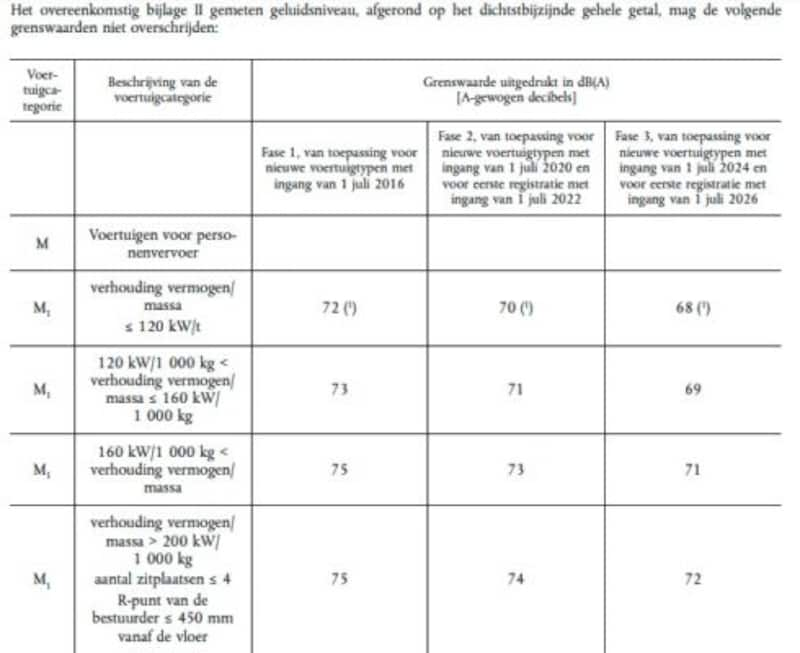
You sometimes see them drive by: loudly roaring and crackling cars that make you wonder if the noise is all legal. But what are the applicable rules regarding the maximum amount of noise a car is allowed to make? That’s less black and white than it seems.
Few things are as inscrutable as European legislation. Yet that is what car manufacturers today have to deal with when it comes to the noise standards for their models. There is no general noise standard for a European type approval. For cars with less than nine seats (category M1), the horsepower-to-weight ratio is in principle leading. Cars may also be louder when the number of seats is equal to or less than four or the driver’s R-point, the point where the occupant’s hip is located, is 450 millimeters or less from the floor. The table, taken from European Regulation 540/2014, states that cars that have a type approval after 1 July 2020 may produce a maximum of 74 decibels. From 1 July 2024, that standard will become even stricter.

All kinds of guidelines have been drawn up for measuring the noise production of a car. The noise is in any case measured at the speed at which the car delivers its maximum power, both stationary and driving. The final result will be on the European type approval, which for the RDW is also leading for the APK. Article 5.2.11 of the Vehicle Regulations prescribes: ‘Passenger cars may not produce a noise level higher than the value stated for the vehicle in the vehicle registration register, increased by 2 dB(A) in the vicinity of the outlet of the exhaust system.’
This means that a retrofitted sports exhaust may not be more than 2 decibels above the standard sound level of the car. That may not seem like much, but the value in decibels does not have a linear structure. Around 70 decibels, an increase of 2 decibels therefore represents a considerable difference in hearing, while the same difference is a lot less audible at around 30 decibels. In order to determine how much noise your car is allowed to make, you need to take the value from the vehicle registration register. This corresponds to that of the European type approval.
No entry in the type approval
Does the type approval not state how much noise the car is allowed to make? Then the RDW applies the following basic rule for passenger cars with electric ignition and a maximum weight of 3,500 kilograms: the car may not produce a noise level higher than 95 dB(A) at 3,500 rpm at the mouth of the exhaust system. The same noise standard applies to cars with compression ignition, usually diesels, but at 2,000 rpm. Does the car in question weigh more than 3,500 kilos? Then the speed at which the sound is measured with 1,500 revolutions per minute is still a bit lower.
The upper limit for the noise standard is therefore 95 decibels, but for most modern cars the noise standard is fixed in the type approval. In addition, the RDW does not measure at 3,500 rpm, but at the speed at which the car delivers its maximum power.
– Thanks for information from Autoweek.nl